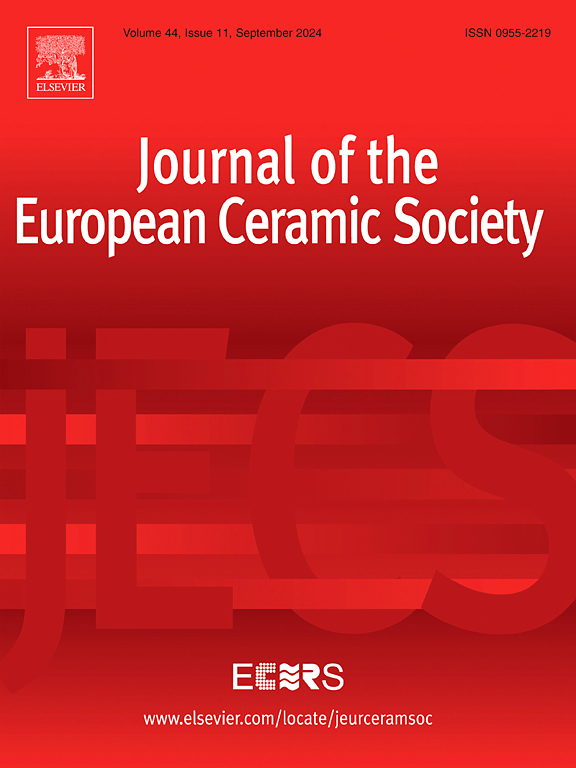Phase stabilization strategy for robust high Q×f values in MgSiO3-based ceramics for millimeter-wave applications
IF 6.2
2区 材料科学
Q1 MATERIALS SCIENCE, CERAMICS
Journal of The European Ceramic Society
Pub Date : 2025-06-03
DOI:10.1016/j.jeurceramsoc.2025.117586
引用次数: 0
Abstract
MgSiO3 ceramics hold promise for millimeter-wave applications owing to their low relative permittivity and cost-effectiveness, but their performance is limited by polymorphism and phase transitions. To mitigate these challenges, we strategically introduced Ge4+ ions to stabilize the orthoenstatite (OEN) phase and prepared MgSi1-xGexO3 ceramics via a solid-state method. X-ray diffraction (XRD) and Raman spectroscopy confirmed a phase transition from clinoenstatite (CEN) to OEN with increasing Ge4+ concentration, resulting in a predominantly OEN phase at x ≥ 0.15. Scanning Electron Microscopy (SEM) revealed that Ge4+ influenced grain size, uniformity and density. The relative permittivity εr increased from 6.07 ± 0.11–7.10 ± 0.09 with increasing x, while the temperature coefficient τf decreased monotonically. Optimal Q×f values of 140,000 ± 11,000 GHz at 13.1 GHz and 216,880 ± 12,840 GHz at 24.4 GHz were achieved at x = 0.15. After one year, the microwave dielectric properties remained robust, underscoring the potential of MgSiO3 for practical millimeter-wave applications.
用于毫米波应用的mgsio3基陶瓷中稳健高Q×f值的相位稳定策略
MgSiO3陶瓷由于其低相对介电常数和成本效益,在毫米波应用中具有前景,但其性能受到多态性和相变的限制。为了缓解这些挑战,我们战略性地引入了Ge4+离子来稳定正长辉石(OEN)相,并通过固态方法制备了MgSi1-xGexO3陶瓷。x射线衍射(XRD)和拉曼光谱证实,随着Ge4+浓度的增加,斜钙辉石(CEN)向OEN转变,在x ≥ 0.15处主要为OEN相。扫描电镜(SEM)显示,Ge4+影响了晶粒尺寸、均匀性和密度。随着x的增大,相对介电常数εr从6.07 ± 0.11-7.10 ± 0.09逐渐增大,而温度系数τf单调减小。最优问×f的值140000 ± 11000 GHz 13.1 GHz和216880 ±12840 GHz 24.4 GHz 0.15 x = 实现。一年后,MgSiO3的微波介电性能保持稳定,这表明MgSiO3在实际毫米波应用中的潜力。
本文章由计算机程序翻译,如有差异,请以英文原文为准。
求助全文
约1分钟内获得全文
求助全文
来源期刊

Journal of The European Ceramic Society
工程技术-材料科学:硅酸盐
CiteScore
10.70
自引率
12.30%
发文量
863
审稿时长
35 days
期刊介绍:
The Journal of the European Ceramic Society publishes the results of original research and reviews relating to ceramic materials. Papers of either an experimental or theoretical character will be welcomed on a fully international basis. The emphasis is on novel generic science concerning the relationships between processing, microstructure and properties of polycrystalline ceramics consolidated at high temperature. Papers may relate to any of the conventional categories of ceramic: structural, functional, traditional or composite. The central objective is to sustain a high standard of research quality by means of appropriate reviewing procedures.
 求助内容:
求助内容: 应助结果提醒方式:
应助结果提醒方式:


